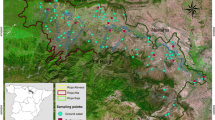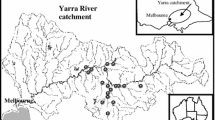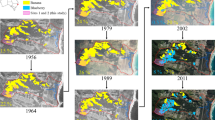Abstract
Fungicides are regularly applied in horticultural production systems and may migrate off-site, potentially posing an ecological risk to surface waterways. However, few studies have investigated the fate of fungicides in horticultural catchments. This study investigated the presence of 24 fungicides at 18 sites during a 5-month period within a horticultural catchment in southeastern Australia. Seventeen of the 24 fungicides were detected in the waterways, with fungicides detected in 63% of spot water samples, 44% of surface sediment samples, and 44% of the passive sampler systems deployed. One third of the water samples contained residues of two or more fungicides. Myclobutanil, trifloxystrobin, pyrimethanil, difenoconazole, and metalaxyl were the fungicides most frequently detected, being present in 16–38% of the spot water samples. Iprodione, myclobutanil, pyrimethanil, cyproconazole, trifloxystrobin, and fenarimol were found at the highest concentrations in the water samples (>0.2 μg/l). Relatively high concentrations of myclobutanil and pyrimethanil (≥120 μg/kg dry weight) were detected in the sediment samples. Generally the concentrations of the fungicides detected were several orders of magnitude lower than reported ecotoxicological effect values, suggesting that concentrations of individual fungicides in the catchment were unlikely to pose an ecological risk. However, there is little information on the effects of fungicides, especially fungi and microbes, on aquatic ecosystems. There is also little known about the combined effects of simultaneous low-level exposure of multiple fungicides to aquatic organisms. Further research is required to adequately assess the risk of fungicides in aquatic environments.

Similar content being viewed by others
References
American Public Health Association (2005) Standard methods for the examination of water and wastewater, 21st edn. APHA Association, American Waterworks Association, Washington, DC
Australian and New Zealand Environment and Conservation Council/Agriculture and Resource Management Council of Australia (2000) ANZECC/ARMCANZ, New Zealand
Baas J, Jager T, Kooijman SALM (2009) A model to analyze effects of complex mixtures on survival. Ecotoxicol Environ Safe 72:669–676
Bermudez-Couso A, Arias-Estevez M, Novoa-Munoz JC, Lopez-Periago E, Soto-Gonzalez B, Simal-Gandara J (2007) Seasonal distributions of fungicides in soils and sediments of a small river basin partially devoted to vineyards. Water Res 41:4515–4525
Bureau of Meteorology (2010) Climate data online. BOM, Commonwealth of Australia, New South Wales
DeLorenzo ME, Scott GI, Ross PE (2001) Toxicity of pesticides to aquatic microorganisms: a review. Environ Toxicol Chem 20:84–98
European Food Safety Authority Journal (2011) http://www.efsa.europa.eu/en/publications/efsajournal.htm. Accessed 8 August 2011
Gillom RJ, Barbash JE, Crawford CG, Hamilton PA, Martin JD, Nakagaki N et al (2006) The quality of our nation’s waters―pesticides in the nation’s streams and groundwater, 1992–2001. United States geological survey circular 1291. USGS, Reston
Gregoire C, Payraudeau S, Domange N (2010) Use and fate of 17 pesticides applied on a vineyard catchment. Int J Environ Anal Chem 90:406–420
Hildebrandt A, Guillamón M, Lacorte S, Tauler R, Barceló D (2008) Impact of pesticides used in agriculture and vineyards to surface and groundwater quality (North Spain). Water Res 42:3315–3326
International Union of Pure Applied Chemistry (2010) Pesticide properties database. http://agrochemicals.iupac.org. Accessed 2 April 2010
Leonard AW, Hyne RV, Pablo F (2002) Trimethylpentane-containing passive samplers for predicting time-integrated concentrations of pesticides in water: laboratory and field studies. Environ Toxicol Chem 21:2591–2599
Maltby L, Brock TCM, van den Brink PJ (2009) Fungicide risk assessment for aquatic ecosystems: importance of interspecific variation, toxic mode of action, and exposure regime. Environ Sci Technol 43:7556–7563
McConnell S, Wightwick A, Smith T, Porteous C (2003) Code of environmental best practice for viticulture―Sunraysia region, volume 1. In: Environmental best practices. Department of Primary Industries, Melbourne
Milenkovski S, Baath E, Lindgren PE, Berglund O (2010) Toxicity of fungicides to natural bacterial communities in wetland water and sediment measured using leucine incorporation and potential denitrification. Ecotoxicology 19:285–294
MWH (2007) Drinking water quality risks in Melbourne’s open water supply catchments: development of a risk quantification. Final report. Melbourne Water, Melbourne
Nørgaard K, Cedergreen N (2010) Pesticide cocktails can interact synergistically on aquatic crustaceans. Environ Sci Pollut Res 17:957–967
Pesticide Action Network (2011) PAN pesticides database. PAN, North America. www.pesticideinfo.org/. Accessed 9 April 2011
Rabiet M, Margoum C, Gouy V, Carluer N, Coquery M (2010) Assessing pesticide concentrations and fluxes in the stream of a small vineyard catchment―effect of sampling frequency. Environ Pollut 158:737–748
Rayment GE, Higginson FR (1992) Australian laboratory handbook of soil and water chemical methods. Inkata Press, Melbourne
Schafer RB, Pettigrove V, Rose G, Allinson G, Wightwick A, Von der Ohe PC et al (2011) Effects of pesticides monitored with three sampling methods in 24 sites on macroinvertebrates and microorganisms. Environ Sci Technol 45:1665–1672
Solomon K, Giesy J, Jones P (2000) Probabilistic risk assessment of agrochemicals in the environment. Crop Protect 19:649–655
United States Environmental Protection Agency (2006) ECOTOX database. USEPA. http://cfpub.epa.gov/npdes/aforule.cfm. Accessed 12 June 2006
Widenfalk A, Svensson JM, Goedkoop W (2004) Effects of the pesticides captan, deltamethrin, isoproturon, and pirimicarb on the microbial community of a freshwater sediment. Environ Toxicol Chem 23:1920–1927
Widenfalk A, Bertilsson S, Sundh I, Goedkoop W (2008) Effects of pesticides on community composition and activity of sediment microbes―responses at various levels of microbial community organization. Environ Pollut 152:576–584
Wightwick A, Allinson G (2007) Pesticide residues in Victorian waterways: a review. Austral J Ecotoxicol 13:91–112
Wightwick A, Allinson G (2008) Compilation of agrochemicals registered for use in Victoria and their physical–chemical properties. Department of Primary Industries, Melbourne
Wightwick A, Mollah M, Partington D, Allinson G (2008) Copper fungicide residues in Australian vineyard soils. J Agric Food Chem 56:2457–2464
Wightwick A, Walters R, Allinson G, Reichman SM, Menzies NW (2010) Environmental risks of fungicides used in horticultural production systems. In: Carisse O (ed) Fungicides. InTech, Reijka, pp 273–304
Acknowledgments
This study was supported by Melbourne Water; the Department of Primary Industries VIC, Australia (DPI) Future Farming Systems Research Key Project FF104 Accountable Agriculture (Project MIS No. 06889, 08162); and the Cooperative Research Centre for Contamination Assessment and Remediation of the Environment (We also acknowledge Simon Phelan and David Allen (DPI, Werribee) for assistance with sample analysis as well as Steve Marshall and other staff from University of Melbourne for their help with field sampling.
Author information
Authors and Affiliations
Corresponding author
Rights and permissions
About this article
Cite this article
Wightwick, A.M., Bui, A.D., Zhang, P. et al. Environmental Fate of Fungicides in Surface Waters of a Horticultural-Production Catchment in Southeastern Australia. Arch Environ Contam Toxicol 62, 380–390 (2012). https://doi.org/10.1007/s00244-011-9710-y
Received:
Accepted:
Published:
Issue Date:
DOI: https://doi.org/10.1007/s00244-011-9710-y




